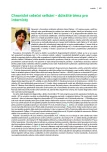-
Medical journals
- Career
Outpatient treatment of proximal deep vein thrombosis
Authors: Dalibor Musil
Authors‘ workplace: I. interní klinika kardiologická LF UP a FN Olomouc
Published in: Vnitř Lék 2018; 64(9): 887-892
Category: Actualities
Overview
The treatment of deep vein thrombosis (DVT) is based on anticoagulation with heparin, warfarin and direct oral anticoagulants. According to the 9th ACCP Recommendation, for patients with DVT of the lower limbs, where the clinical state and home conditions permit, preference is given to home treatment over hospitalization. Despite that, the majority of patients with acute DVT still tend to be hospitalized, in particular when proximal thrombosis from the popliteal vein upward is involved. Furthermore, the recommendations do not describe proximal (iliofemoral) DVT as exceptional and more serious. Randomized and observation studies have shown faster relief from pain and swelling in patients keeping to the regimen of early mobilization wearing compression means, compared to patients keeping bed rest, while the incidence of new cases of PE was the same for both groups. In the acute phase of the disease compression and walking exercise is essential which, along with internal thrombolytic mechanisms of the body, accelerates recanalization and development of the collateral blood vessels in the deep muscular compartment of the lower limb. Two case studies demonstrate an outpatient approach to the therapy of proximal DVT.
Key words:
compression treatment – direct oral anticoagulants – low molecular weight heparin – venous thromboembolism
Sources
1. Kearon C, Akl EA, Ornelas J et al. Antithrombotic Therapy for VTE Disease: CHEST Guideline and Expert Panel Report. Chest 2016; 149(2): 315–352.
2. Bultas J, Karetová D. Nízkomolekulární hepariny – jejich význam v současné praxi. Interní Med 2011; 13(11): 440–444.
3. Hacobian M, Shetty R, Niles CM et al. Once daily enoxaparin for outpatient treatment of acute venous thrombosis: a case-control study. Clin Appl Thromb Hemost 2010; 16(1): 21–25.
4. Guyatt HG, Akl EA, Crowther M et al. Atithrombotic therapy and prevention of thrombosis, 9th ed: American College of Chest Physicians, evidence-based clinical practice guidelines. Chest 2012; 141 (Suppl 2): 7S-47S.
5. Masuda EM, Kessler DM, Kistner RL et al. The natural history of calf vein thrombosis: lysis of thrombi and development of reflux. J Vasc Surg 1998; 28(1): 67–73.
6. Musil D. Regrese hluboké žilní trombózy. Vnitř Lék 2000; 56(1): 16–18.
7. Bergan JJ, Schmid-Schönbein GW, Coleridge Smith PD et al. Chronic venous disease. N Engl J Med 2006; 355(5): 488–498.
8. Kearon C, Kahn SR, Agnelii G et al. Antithrombotic therapy for venous thromboembolic disease: American College of Chest Physicians Evidence-Based Clinical Practice Guidelines (8th Edition). Chest 2008; 133(Suppl 6): 454S-545S.
9. Chen G, Shi W, He X et al. Feasibility of continuous, catheter-directed thrombolysis using low-dose urokinase in combination with low molecular-weight heparin for acute iliofemoral venous thrombosis in patients at risk of bleeding. Exp Ther Med. 2017; 13(2): 751–758.
10. Enden T, Haig Y, Kløw NE et al. Long-term outcome after additional catheter-directed thrombolysis versus standard treatment for acute iliofemoral deep vein thrombosis (the CaVenT study): a randomised controlled trial. Lancet 2012; 379(9810): 31–38.
11. Vendantham S, Goldhaber SZ, Julian JA et al. Pharmacomechanical catheter-directed thrombolysis for deep-vein thrombosis. N Engl J Med 2017; 377(23): 2240–2252.
Labels
Diabetology Endocrinology Internal medicine
Article was published inInternal Medicine

2018 Issue 9-
All articles in this issue
- Pathophysiology, causes and epidemiology of chronic heart failure
- What we know about epidemiology of heart failure in Slovakia and globally
- Diagnosis of heart failure: the new classification of heart failure
- Pharmacological therapy for chronic heart failure
- Comorbidities in heart failure
- Arrhythmias and conductance disturbances and heart failure
- Otto Kahler and his family (on the 125th anniversary of his death): I. Ancestors
- Outpatient treatment of proximal deep vein thrombosis
- The heart transplantation
- Internal Medicine
- Journal archive
- Current issue
- Online only
- About the journal
Most read in this issue- Diagnosis of heart failure: the new classification of heart failure
- Pathophysiology, causes and epidemiology of chronic heart failure
- Outpatient treatment of proximal deep vein thrombosis
- What we know about epidemiology of heart failure in Slovakia and globally
Login#ADS_BOTTOM_SCRIPTS#Forgotten passwordEnter the email address that you registered with. We will send you instructions on how to set a new password.
- Career

